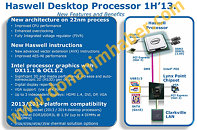Monday, February 13th 2012

Intel Haswell Packs DirectX 11.1 Graphics
Some time in 2013, Intel will launch its new processor architecture, codenamed "Haswell", which will go on to succeed "Ivy Bridge". More than an year away from its market entry, Haswell has already been exhaustively documented, but not many got into the details about its embedded graphics processor. That is, until now. A new internal slide sourced by DonanimHaber details the integrated GPU (iGPU), it appears like Intel has solid plans for home users.
To begin with, Haswell's iGPU will be DirectX 11.1 compliant, which means it will take advantage of API optimizations that improve performance, for typical desktop usage scenarios. Apart from support for a new DirectCompute architecture, it will also support OpenCL 1.2, which speeds up certain GPGPU-optimized applications. More importantly, the iGPU will be designed around a new stereoscopic 3D standard called Auto-Stereoscopic 3D (AS3D), which will take the likes of Blu-ray 3D acceleration, stereo 3D photos, etc., to the masses. Currently, it takes at least an entry-level GeForce or Radeon GPU to for acceptable performance with stereo 3D.Another significant change is what Intel refers to as "digital display repartition". Until now, Intel processors with embedded graphics relied on the PCH to perform all display I/O functions, the iGPU communicates to the PCH over the Flexible Display Interface (FDI), a special data link dedicated to this function. With Haswell, digital display outputs (such as DVI, HDMI, DisplayPort), will be wired directly to the CPU socket, while analog display (such as D-Sub), will be handled by a RAMDAC located in the PCH, to which a digital signal is sent over FDI. This design ensures there's no performance bottleneck with higher resolution digital displays, while at the same time, ensuring analog display quality isn't affected by the RAMDAC being located in the GPU die, where it's bound for interference by some pretty high-current circuits.
Source:
DonanimHaber
To begin with, Haswell's iGPU will be DirectX 11.1 compliant, which means it will take advantage of API optimizations that improve performance, for typical desktop usage scenarios. Apart from support for a new DirectCompute architecture, it will also support OpenCL 1.2, which speeds up certain GPGPU-optimized applications. More importantly, the iGPU will be designed around a new stereoscopic 3D standard called Auto-Stereoscopic 3D (AS3D), which will take the likes of Blu-ray 3D acceleration, stereo 3D photos, etc., to the masses. Currently, it takes at least an entry-level GeForce or Radeon GPU to for acceptable performance with stereo 3D.Another significant change is what Intel refers to as "digital display repartition". Until now, Intel processors with embedded graphics relied on the PCH to perform all display I/O functions, the iGPU communicates to the PCH over the Flexible Display Interface (FDI), a special data link dedicated to this function. With Haswell, digital display outputs (such as DVI, HDMI, DisplayPort), will be wired directly to the CPU socket, while analog display (such as D-Sub), will be handled by a RAMDAC located in the PCH, to which a digital signal is sent over FDI. This design ensures there's no performance bottleneck with higher resolution digital displays, while at the same time, ensuring analog display quality isn't affected by the RAMDAC being located in the GPU die, where it's bound for interference by some pretty high-current circuits.

22 Comments on Intel Haswell Packs DirectX 11.1 Graphics
you can get away with emulators but just barely.
shitty drivers live forever.
I think people fail to appreciate just how much effort Intel is now putting into their GPUs. They have come a long way in a short period of time. These things don't happen overnight.
Interesting to note that Haswell has integrated voltage controller! This means no more volt tweaking on Motherboard. Does that mean it is less manual overclock friendly? Or does it mean that the CPU can figure out the overclocking bit all by itself? in other words, an idiot-proof overclocking feature?
It's just the driver side that fails to deliver. The latest Atom was suppose to be DX10, but that's not what the spec sheets say now. DX9 forever!
Rumors abound that DX11.1 will not make it when release comes. x64 seems to be giving the Intel driver team trouble.
Intel can't even write drivers to work with the hardware they have and thus have to downgrade the hardware to match what they can do with the drivers.
Not a good thing when you can't use the hardware your advancing because of the lack of your driver team not being able to write something that works on just a basic level.
The latest Atom was suppose to be DX10.1, but now is only DX9. What happened?
edit:
Source: AnandtechIntel just released the second driver update to Sandy Bridge since it launched. So how long until Intel gets DX10.1 on Atom functional?
It sounds like we're on the same page. I just interpreted your comment differently.
doing that makes alot of sense and explains why amd put such little effort in improving floating point in bulldozer and are defining cores by their integer units. so just like intel sandy bridge does things like quick sync to accelerate rendering and what not, such has to be put into perspective when designing haswell. dx11.1 and stuff like that is only scratch on the surface compared to the real deal, as the main focus for intel is computation first, graphics comes as a bonus